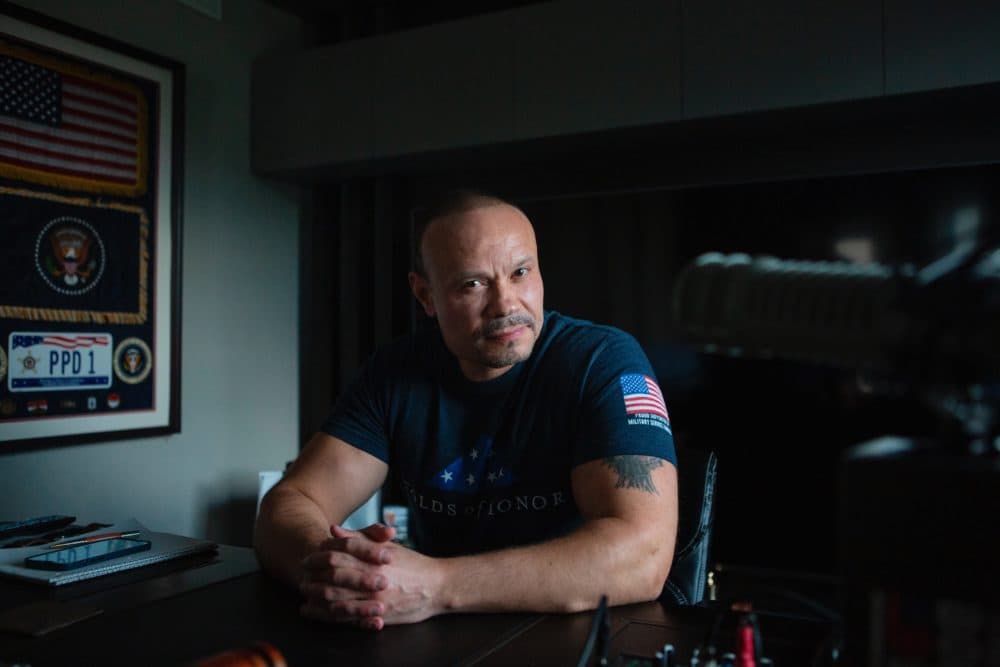Advertisement
Far-right radio and the fight for American democracy
Resume
On the Jan. 6 episode of Steve Bannon's show War Room, the message is clear:
"Trump won. And Biden’s illegitimate. And you’re just gonna have to live with it, okay? Because we're not backing off one inch."
Right-wing talk radio and podcasts have influence and reach. For their audiences, the Jan. 6 insurrection was just the beginning.
"To them, Jan. 6 was just the start in an ongoing fight to wrest the country away from those they believe have stolen from them," The Bulwark's Tim Miller says.
Today, On Point: We explore what far-right radio and podcasts are telling Americans about their own democracy.
Guests
Tim Miller, writer-at-large at The Bulwark. Author of the recent piece "I Spent Insurrection Week Listening to Steve Bannon." Host of Not My Party on Snapchat. (@Timodc)
Cynthia Miller-Idriss, professor of law and criminology at American University and director of the Polarization and Extremism Research and Innovation Lab (PERIL). Author of "Hate in the Homeland: The New Global Far Right." (@milleridriss)
Communities can visit this link for more information on PERIL.
Interview Highlights
On takeaways from Steve Bannon's insurrection week shows
Tim Miller: “There are these bubbles, these information bubbles in this country that there are certain people that are living exclusively in. And I think it's important to examine what is happening outside of your bubble. And I think that had more people in the period between November and January been listening and taking seriously the comments from people like Bannon. I think that we would have been better prepared for what was going to happen on January 6th, and I don't want to make that mistake again.
"And my biggest takeaway from spending 16 hours with Steve Bannon recently was that I wasn't even exactly sure that the tape that you played in the intro from Jan. 5, 2021, whether that was the clip from before the insurrection, or whether that was a clip from recently. And that is how unchanged the tone is from his show. That is how unchanged the fact that Joe Biden was inaugurated has made his show, and others in this universe.
"And I would sort of separate the avowedly insurrectionist, the alternate universe description of what happened in the 2020 election. And what should happen in the 2024 election, which is a call to arms to ensure that this never happens again. This being the Democrats are allowed to win an election. I would separate that, which happens on Bannon's and Bongino's show, from some of the other conservative talk radio.
"I think that there is an explicitly pernicious strain that emanates from Bannon and a handful of others, that is a religious crusade that is calling people to ensure that Donald Trump and his minions are in power forever. And to delegitimize anyone who claims otherwise. And I think that that strain led to Jan. 6."
On the influence and reach of far-right radio and podcasts
Tim Miller: "Distrust of the media on the right ... goes back to Spiro Agnew, probably before. Here's the difference. Is again, in that time in the 60s, 70s, 80s, there were still only so many options. You still had to read your local paper. You still saw your local news that night. Different information sources were getting in. If you're listening to Bongino, and Bannon and watching Tucker at night, you know that's seven hours of content a day right there. No other information is breaking in. So I think this is important.
"If you look at the numbers, just in the podcast, Bongino and Bannon are always in the top 10. They're right next to the NPR Morning podcast at the top of the list, for a sense of how big their audience is. But it's not just also podcasts. I mean, Bannon's show, for example, is streaming on Apple TV, and Roku and the Dish. Bongino has over-the-air radio, which is six times bigger than podcasts, in markets all across the country.
"So Bannon claims, you said there are 30 million at the start. Now they're claiming up to 100 million. Who knows, this is probably some exaggeration. But I think there's no doubt if you look at objective metrics that these are the most listened to shows, on the equivalent with the big shows on the left: The Daily, Pod Save America, Rachel Maddow."
On what's different about these podcasts now vs. in the past
Cynthia Miller-Idriss: "It is a little bit different right now. I mean, there are a couple of different ways in which the disinformation ecosystem is changing. And one is ... the sheer volume of it. And the broad breadth of places that you can go to listen to it, and to encounter it.
"But the other thing is that because of how much of our time we spend in online contexts — and the way that disinformation, or propaganda, or salacious content kind of finds you. ... Through algorithms, or through pockets of things like online gaming, or YouTube channels about hobbies where somebody's inserted information into something. You're just much more likely, within a couple of clicks in your daily life, to encounter disinformation that can lead you down an ever-expanding series of rabbit holes, into different dedicated podcasts or shows, or whatever it is.
"And so it used to be much more of a destination that you had to seek out. You had to look for, sign up for a newsletter, or subscribe to something or join a group. And I think it's just much more likely today that people encounter it when they already have sort of been seeded to distrust media, and facts, and science and knowledge. Through the introduction of things like alternative facts, and all the other kinds of undermining that we've seen over the past few years."
On the most important factors that push someone towards extremist thought
Cynthia Miller-Idriss: "Generally the biggest and most important thing that has to happen for people to become willing to use violence, and mobilize to use violence for political or ideological reasons, is that they come to see the world as divided into very clear and bounded 'Us v. them' categories in which the other group poses an existential threat to you, your family, your way of life or your future.
"And so to the extent that that kind of dynamic underpins a lot of this, and just further fuels this idea that they are out to get you, that it's an existential thing. Meaning whether that's because of demographic change — so we get back to the border, and the idea of a great replacement or invasions. Or, it's that Second Amendment rights are going to be taken away from you. Or, that an election was stolen from you, or whatever it is that is posing an existential danger, and you have to rise up.
"That, I think, is where you get the the underpinnings of real serious potential for a fringe among that. Certainly not all the people who believe that, but for fringe actors, more and more of them to believe that they have to act heroically. And really stand up for their people, or their movement, or their freedoms or whatever it is, their rights. And that's where you end up with both lone actor violence, and then in this case of Jan. 6, spontaneous violence. And along with some planned violence for a small minority of people. But real spontaneous violence by thousands of people, who might not have actually planned to be violent on that day."
On ways to protect communities from false information
Cynthia Miller-Idriss: "There's absolutely no quick fix. We're in an immediate crisis. And the crisis kind of intervention tools, I think are going to be different than the longer term needs for media, digital literacy and the kinds of things that have to be incorporated into broad public education. I will say two things that are optimistic for me.
"One, we have been testing a lot of different ways to do what's called video-based inoculation, where you teach people about the propaganda tools, the rhetorical strategies, like the brave truth teller, like the scaffolding of conspiracy theories. And for our first year of projects, we found that it all works. And now we just have to figure out how to scale it up. People can be taught to recognize some of the manipulative tactics. We just have to figure out how to get those kinds of videos and audio tests in front of them.
"The other thing that gives me hope is actually, I just started teaching again last week. And I will say for the first time ever in just the first class, establishing the kind of ground rules. This young generation does not want any part right now of what the older generation is doing. And so they are establishing rules about respect in the classroom, about ideological diversity, about listening to each other. Already 100% beyond where I'd seen previous cohorts of students. I think they are sick of it. And I think that we do have a group of younger kids coming up who just are really disappointed in their parents generation. And then what everybody else has been doing."
From The Reading List
The Bulwark: "I Spent Insurrection Week Listening to Steve Bannon" — "For three hours every day, the Republican coup plotters who inspired the domestic terror attack at the U.S. Capitol last year gather to discuss their next move."
New York Times: "America’s Most Urgent Threat Now Comes From Within" — "For many Americans, the events of Jan. 6 brought the issue of domestic violent extremism to the fore."
This program aired on January 18, 2022.

